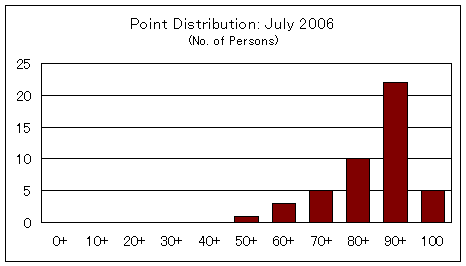
|
Date |
No. of students |
Mean |
Standard deviation |
Maximum |
Minimum |
A |
B |
C |
D (fail) |
|
Jul-3-97 |
25 |
69.0 |
12.9 |
87 |
43 |
28.0% |
52.0% |
20.0% |
0.0% |
|
Jul-21-98 |
27 |
84.8 |
14.7 |
99 |
42 |
77.8% |
18.5% |
3.7% |
0.0% |
|
Sep-6-99 |
14 |
78.5 |
20.4 |
97 |
28 |
50.0% |
42.9% |
0.0% |
7.1% |
|
Sep-12-00 |
13 |
77.8 |
13.0 |
95 |
56 |
61.5% |
30.8% |
7.7% |
0.0% |
|
Jul-25-01 |
39 | 73.7 | 22.5 | 100 | 23 |
46.2% |
28.2% |
15.4% |
10.3% |
| Jul-19-02 | 59 | 88.4 | 10.8 | 100 | 57 | 84.7% | 11.9% | 3.4% | 0.0% |
| Jul-18-03 | 46 | 84.4 | 15.4 | 100 | 26 | 76.1% | 17.4% | 4.3% | 2.2% |
| Jul-23-04 | 40 | 84.2 | 15.1 | 100 | 28 | 72.5% | 25.0% | 0.0% | 2.5% |
| Jul-22-05 | 39 | 82.1 | 14.8 | 100 | 50 | 66.7% | 23.1% | 10.3% | 0.0% |
| Jul-21-06 | 46 | 88.1 | 11.4 | 100 | 52 | 80.4% | 17.4% | 2.2% | 0.0% |
A = 80-100, B = 60-79, C = 40-59, D = 0-39
Comment:
This year, the mean was quite high. This could be because (i) my questions were too easy; (ii) students were particularly good this year; or (iii) my teaching method improved. I don't particularly feel that (i) was true. I hope the reason for high marks was a combination of (ii) and (iii).
As a general rule, professors should not give out too many A's. However, if relatively complex issues were absorbed efficiently because of students' effort or good teaching, I don't feel compelled to give B's or C's to high-performing students just to keep the grade balance. In the last 15 years of my teaching career, I have not lowered the exam standard.
Q1 was a repeat of the past question. The other questions were somewhat new but you should be able to answer them easily if you have followed my web and lectures, and reviewed them before the exam. You see, I don't ask details or tricky questions. I only want to check if you have grasped main points.
The point distribution was skewed to the right, truncated at 100. Unlike some other years, we did not have a twin-peak property. This means that students this year were a uniform group rather than a combination of two groups.
Perhaps I should ask more difficult questions in the future.
